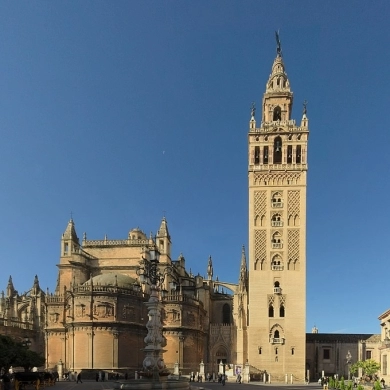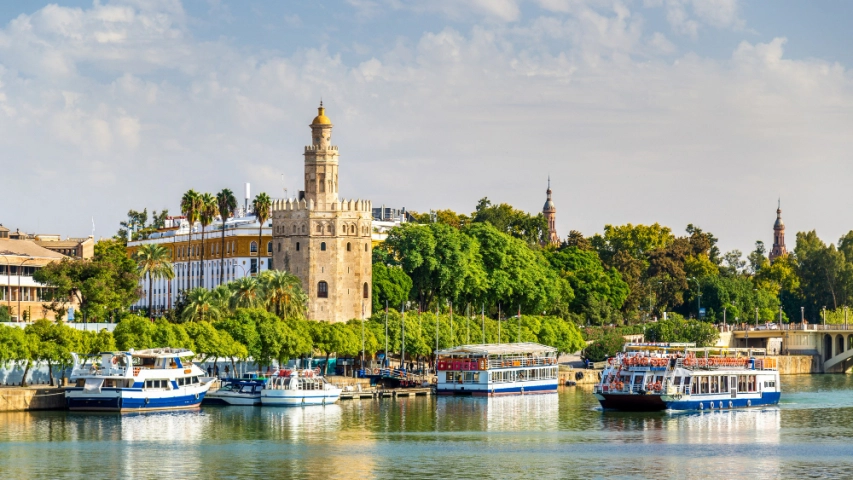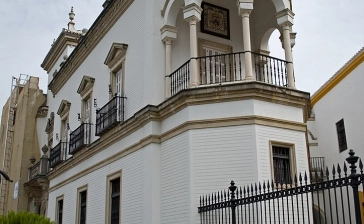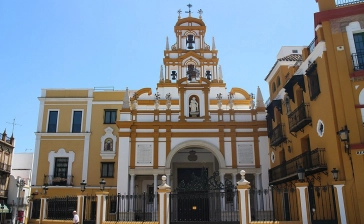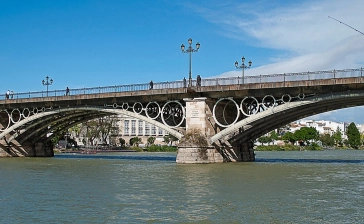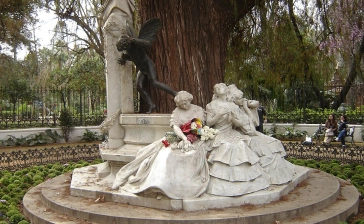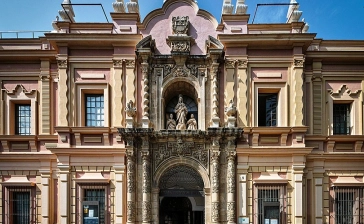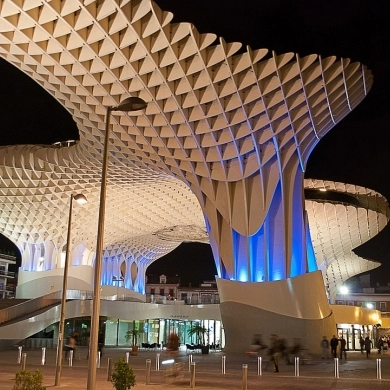Welcome to Seville! A city that leaves a lasting impression and is widely considered special. Its grand monuments, charming neighborhoods like Triana, the sweet fragrance of jasmine in its squares, and the melodious Spanish guitar music echoing in the streets are among the reasons why. Many believe it is the city's rich tradition of festivals, while others argue it is its delicious tapas that sets it apart.
At Motion4Rent, we provide you with important information, including places of interest and tourist offices, accessible beaches, adapted excursions, theme parks, accessible restaurants, and other offers for visitors with reduced mobility. We hope you have a wonderful stay in Seville!
- Office Plaza del Triunfo, 1 Phone 954210005
- Office Estación Trenes Santa Justa, in front of platform 6-7, Avda. Kansas City s/n Phone (+34) 954782002
https://www.turismosevilla.org/en/organize-your-trip/tourist-offices/seville-centre-tourist-office
Seville - San Pablo International Airport:
Seville-San Pablo Airport is located 3 kilometers northeast of the city of Seville and is the second-largest airport in terms of passenger traffic in Andalusia, after Malaga-Costa del Sol Airport. It is also the leading airport in terms of goods volume.
The terminal, designed by renowned architect Rafael Moneo, showcases Sevillian and Andalusian culture with its incorporation of three traditional elements: a mosque, a palace, and orange trees.
For the convenience of passengers with reduced mobility, Seville airport provides a free assistance service. There are meeting points throughout the airport and surrounding areas to offer appropriate support to those who need it. To avail of this service, passengers must inform the airport of their special needs at least 48 hours before their flight by using the website https://www.aena.es/pmr/inicio?lang=es or by calling (+34) 91 321 10 00. This service is provided free of charge.
Bus:
Seville has 44 day lines and 9 night lines that serve nearly all areas of the city, both in the center and suburbs. The official website of Tussam is https://www.tussam.es/
City buses run from 6:00 am to 11:00 pm every day, with the exception of holidays when they start one hour later. The frequency of buses varies depending on the line and schedule, with an average wait time of 15 to 20 minutes.
Most of the city's public buses are "low-floor" type (without steps inside) and have a ramp at the center door for ease of access. Each bus is equipped to transport one adult in a wheelchair, and up to two children in small chairs.
For tourists, the Seville sightseeing bus is another way to see the main monuments of the city comfortably. The bus stops near the Torre del Oro and has two buses, each with room for one wheelchair.
Taxi:
In Seville, the main attractions are located in the city center, so taxi rides are typically short. Taxis are white and have a distinctive sign on the roof of the vehicle and the license number displayed on the side doors. You can either hail a taxi from a designated taxi rank or stop one on the street.
Adapted taxis are conventional vehicles that have been modified to meet the needs of people with reduced mobility, including those who use wheelchairs. The authorities aim to have at least 5% of taxi licenses correspond to licenses for adapted vehicles. These taxis can be used by anyone, but people with reduced mobility have priority in cities where the number of adapted taxis is limited.
Metro:
The Seville Metro is a light rail system serving the city of Seville and its metropolitan area. It currently consists of one operational line with 22 stations spread across four municipalities in the metropolitan area.
All metro facilities are accessible for users with reduced mobility. Stations are designed without obstacles or architectural barriers and are well-lit for easy accessibility and safety. Elevators connect street level with the station lobbies and platforms. There are also adapted steps of a special width for people with reduced mobility.
Trains are 100% low-floor, ensuring accessibility for all users. The distance between the train and the platform is suitable for approved wheelchairs. There are also designated seats for people with reduced mobility on all trains.
Barrio de Santa Cruz (Santa Cruz neighborhood)
The Barrio de Santa Cruz is a neighborhood in Seville, Spain known for its narrow, labyrinthine streets and historic architecture. It was once the Jewish quarter of the city and is now home to stately homes, courtyards, and plazas, such as Santa Cruz Plaza, where the remains of the famous painter Bartolomé Esteban Murillo are located.
The Callejón del Agua, a street next to the city wall and parallel to the Real Alcázar Gardens, is a must-visit for its historical significance. Other charming alleys in the neighborhood include the alley of the Jewish Quarter, connecting Vida Street and the Patio de Banderas, and the small barreduela connecting the Plaza Virgen de los Reyes and the Plazoleta de Santa Marta.
Visitors are encouraged to explore the neighborhood and get lost in its charming streets.
Triana neighborhood
It is probably the most special neighborhood of Seville, famous for its history, its idiosyncrasy and its significance.
This population center on the right bank of the river Betis (Roman name of the Guadalquivir), served the Roman legions to establish a camp, near Italica and in front of Híspalis. It was the Almohads who built the first bridge linking it to the city, a bridge of boats located where today is the famous Triana Bridge.
In the XV and XVI centuries, Triana was present in those maritime expeditions that aspired to know new worlds. Its School of Seafarers instructed many sailors of the time who took part in voyages such as the arrival of Christopher Columbus in America or the Round the World Voyage of Magellan and Elcano, whose departure also took place from these shores. In the Plaza de Cuba, a sphere marks the zero mile of the first circumnavigation of the Earth.
And history has also left its dark chapter. The Castle of San Jorge was the scene of the fearsome persecutions of the Inquisition. Today you can visit its remains and learn about its history under the Triana Market.
But, Triana has much to discover in every corner, in the courtyard of a tenement house, in a bar or a store of all life. If you come to Triana, you will travel to a neighborhood, above all, authentic.
The first thing you notice when you take your first steps in Triana is that it has its own identity, the result of being a neighborhood born on the other side of the river. This separation that marks the Guadalquivir River with Seville has not prevented, however, that Triana has provided many of the main signs of identity of the city. Unmistakable features such as ceramic art or flamenco art have their germ in Triana. And it is no coincidence that in both cases we speak of "art".
Triana is the birthplace of a large number of flamenco artists (great guitarists, singers and tonadilleras have been born or raised here), famous bullfighters, famous potters, historic sailors .... Surely this neighborhood has the natural capacity to inspire you.
Strolling around Seville in a wheelchair: popular street markets
Plaza de la Alfalfa. Sunday morning: market of birds, dogs and other animals.
Bus: Plaza Encarnación, B2, 10, 11, 12, 15, 20, 24, 27, 32.
Feria Street. Thursday morning: market of antiques, old books and useful or useless things of personalized use. Bus: C/ Feria 13, 14
Next to the new branch of the river, in the parking lot of Expo'92. Sunday mornings: market of antiques, handicrafts, books and useful or useless things of personalized use. Bus: Isla de la Cartuja C1 C2.
Mareaviva, one of the favorite places to eat in Seville.
Mareaviva is a highly recommended restaurant in Seville for those who love seafood and Mediterranean cuisine. Its menu features traditional Sevillian dishes with a contemporary twist, with a focus on fish and seafood dishes, as well as some options for meat lovers. The service is excellent and the ambiance is modern and comfortable. Although not the most budget-friendly option, prices are reasonable for the quality of the food, with an average cost of 20 euros for a couple of tapas and a drink. The restaurant is located in the Nervión neighborhood, near the Ramón Sánchez-Pizjuán Stadium.
Wheelchair accessible.
- Address and contact
- Calle Luis Arenas Ladislao, 151, 41005 Seville
- Telephone: 954 57 41 76
Depikofino
Depikofino is a gastrobar in the Buhaira area of Seville that offers a combination of traditional and modern cuisine. The atmosphere is rough and rustic, while the dishes are refined and sophisticated. The menu features a variety of options, including tapas, raciones, and full portions, with options for both meat and seafood lovers. The beef sirloin with rosemary smoke and the duck tataki with strawberry and chili sauce are highly recommended. Despite the appearance, the food is much better than the decoration, and the restaurant offers excellent service at an affordable price, making it one of the best value for money restaurants in Seville.
The facilities are made wheelchair accessible
- Address and contact:
- Avenida Eduardo Dato, 29, 41018 Seville
- Telephone: 954 53 29 57
Casa Morales
Casa Morales is a traditional restaurant in the heart of Seville, known for its classic Sevillian dishes and rustic tavern-like atmosphere. Visitors can find a range of popular dishes such as carrillada, Iberian pinchito, gazpacho, various montaditos, san jacobos, ensaladilla, potatoes with aioli, among others. The food is excellent and reasonably priced with tapas ranging from 2-4 euros and the option of larger portions. The restaurant is recognizable by its large jars and has a cozy and rustic feel, making it a great choice for those seeking traditional Andalusian cuisine in a classic setting.
Accessibility: Wheelchair accessible.
- Address and contact:
- Calle García de Vinuesa, 11, 41001 Seville.
- Telephone: 95422 12 42
El Eslava
It is a very traditional and cozy place with a great atmosphere. The service is very good and the food is excellent - the portions are generous and the flavors are very traditional and intense. It's definitely a must-visit for anyone looking for an authentic tapas experience in Seville, and with prices ranging from 3-5 euros per tapa, it's a great option for those on a budget.
- Address and contact:
- Calle Eslava, 3, 41002 Seville
- Telephone: 954 90 65 68
Bodeguita Reyes Antonio Romero, one of the best options where to eat in Seville cheap and good.
In the heart of Seville, a few meters from the Maestranza Bullring, is the Bodeguita Reyes Antonio Romero, an excellent tapas bar, affordable, very tasty and with good service. It is the youngest of the four bodeguitas Romero that exist in Seville (all great). In this particular case, it is a very cozy and modern bar, ideal for a more informal drink.
We have been there several times and we always order the same thing: the piripí, the sevillano (one of the star dishes), the tortilla de patatas, the pimiento relleno de bacalao or the berenjena rellena (stuffed eggplant). You can eat tapas (they cost around 2.50 euros) and the quality is excellent. It is usually quite full, so it is advisable not to arrive too late because you may run out of room.
- Address and contact:
- Calle Antonia Díaz, 5, 41001 Sevilla
- Telephone: 954 22 14 55
Castizo
One of the most charming restaurants in Seville (and also one of my favorites) is Castizo, a place located in the heart of the city, a few meters from the Triana Bridge and the Maestranza bullring. It belongs to the same group of restaurants as Torres y García (which we have also included in this article) and is a bet for traditional dishes with an original touch.
The place is very nice and the presentation of the dishes is impeccable. You can order both tapas (between 3 and 5 euros) and portions, which can be shared if there are several of you. Some of our favorites: the patatas bravas, the shrimp montadito with aioli, the boneless grilled chicken, the mini serranito or the whole fried onion with cream cheese from Ronda. The value for money is excellent and is around 15 euros per person.
- Address and contact:
- Calle Zaragoza, 6, 41001 Sevilla
- Telephone: 955 18 05 62
